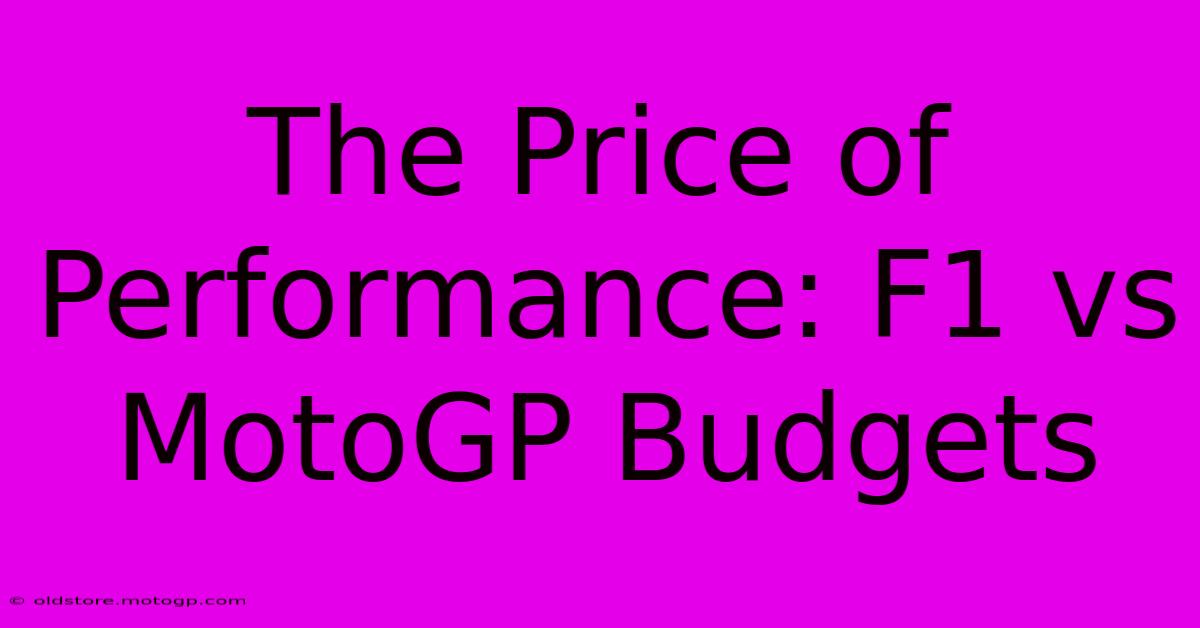The Price Of Performance: F1 Vs MotoGP Budgets

Table of Contents
The Price of Performance: F1 vs MotoGP Budgets
The roar of the engines, the breathtaking speeds, the nail-biting finishes – Formula 1 and MotoGP are two of the most exhilarating motorsport spectacles on the planet. But beyond the glamour and the glory lies a stark reality: the staggering cost of competing at the highest level. This article delves into the financial complexities of these two racing giants, comparing their budgets and exploring what drives the exorbitant price tags.
The Astronomical Figures: F1 Budget Caps and Reality
For years, Formula 1 was synonymous with unlimited spending, a free-for-all where the wealthiest teams reigned supreme. However, in a bid to level the playing field and enhance competition, a budget cap was introduced. While the official cap fluctuates, it sits around $140 million per team. This seemingly massive figure, however, only covers specific areas of team expenditure. It excludes driver salaries, marketing costs, and engine development – leaving substantial loopholes.
Beyond the Budget Cap: Hidden Costs in F1
Consider the following significant costs that fall outside the budget cap:
- Driver Salaries: Top F1 drivers command salaries in the tens of millions of dollars annually. These contracts significantly impact a team's overall financial burden.
- Engine Development: The development and maintenance of highly sophisticated Formula 1 engines are incredibly expensive. Teams often invest hundreds of millions into this aspect alone.
- Marketing and Sponsorship: Securing lucrative sponsorship deals and executing effective marketing campaigns are crucial for funding a team's operations. This represents a huge, often hidden, expense.
- Infrastructure and Personnel: Maintaining state-of-the-art facilities, employing hundreds of highly skilled engineers and mechanics, and traveling across the globe for races all add to the substantial costs.
MotoGP's Leaner, but Still Expensive, Machine
Compared to F1, MotoGP operates with comparatively tighter budgets, although precise figures are harder to pin down due to less public transparency. While there isn't a formal budget cap like in F1, teams generally operate with budgets significantly lower than the top F1 teams, perhaps in the range of tens of millions of dollars. However, "leaner" doesn't equate to "cheap."
The Key Cost Drivers in MotoGP
Despite the lower overall budgets, MotoGP teams still face significant expenses:
- Engine Development and Maintenance: While not as complex as F1 engines, MotoGP engines are still highly sophisticated and require substantial investment in research, development, and maintenance.
- Rider Salaries: Top MotoGP riders also earn substantial salaries, though generally less than their F1 counterparts.
- Travel and Logistics: The global nature of the MotoGP calendar necessitates significant expenditure on travel, logistics, and accommodation for the entire team.
- Motorcycle Development and Testing: Continuous development and rigorous testing of motorcycles are crucial for competitiveness, demanding a significant financial commitment.
The Underlying Differences: Technology and Scale
The disparity in budgets isn't just about arbitrary numbers; it reflects fundamental differences between the two sports:
- Technology: F1 cars represent the pinnacle of automotive engineering, incorporating cutting-edge technology and sophisticated materials. This inherently drives up costs. MotoGP bikes, while technologically advanced, are less complex.
- Scale: F1 teams are substantially larger and more complex organizations than their MotoGP counterparts, employing significantly more personnel and requiring larger infrastructure.
Conclusion: A Constant Battle for Performance
Both F1 and MotoGP are showcases of human ingenuity and technological prowess. However, the price of competing at the highest level is undeniably steep. While F1's budget cap attempts to control escalating costs, the hidden expenses remain significant. In MotoGP, although budgets are lower, the quest for performance remains a costly endeavor. The pursuit of victory, in both cases, demands a relentless and expensive commitment. Understanding the financial landscape of these prestigious racing series provides crucial context for appreciating the dedication, innovation, and sheer financial muscle required to compete at the very top.

Thank you for visiting our website wich cover about The Price Of Performance: F1 Vs MotoGP Budgets. We hope the information provided has been useful to you. Feel free to contact us if you have any questions or need further assistance. See you next time and dont miss to bookmark.
Featured Posts
-
Motorcycle Racing The Mental Game For Different Race Types
Feb 22, 2025
-
Experience The Adrenaline Ex Factory Bikes
Feb 22, 2025
-
Beyond Moto Gp A Guide To Diverse Motorbike Racing Disciplines
Feb 22, 2025
-
Moto Gps Most Inspiring Comebacks After Accidents
Feb 22, 2025
-
Moto Gp Austin 2025 Get Closer To The Action
Feb 22, 2025
